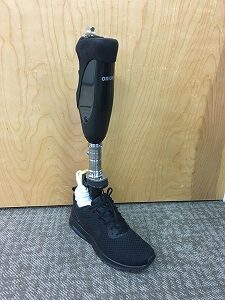How Much Does a Prosthetic Leg Cost?
Last Updated on July 4, 2024
Written by CPA Alec Pow | Content Reviewed by ![]() CFA Alexander Popinker
CFA Alexander Popinker
For individuals who have tragically lost a limb due to injury, disease, or congenital conditions, prosthetic legs serve as essential assistive devices to help restore mobility, stability, and independence to daily living.
But what are the full costs involved when it comes to purchasing and maintaining these customized artificial limbs over time?
A prosthetic leg is a personalized medical device custom-designed and fitted to replace a missing limb and maximize functional mobility. The costs accumulate not only from the initial consultation, fabrication and fitting process, but also from ongoing maintenance, repairs, adjustments, and potential complete replacements that will be required over the owner’s lifetime due to daily wear and component lifespan limitations.
This comprehensive guide covers the full range of expenses involved with different types of prosthetic legs, insurance coverage details, financial assistance programs available, working with your prosthetist, and how to best plan financially to make this life-changing investment accessible.
How Much Does a Prosthetic Leg Cost?
A new prosthetic leg can cost from $3,000 to $100,000+ depending on the amputation level, required components, materials utilized, incorporation of advanced technologies, and any custom special features.
On average, a prosthetic leg ranges from $5,000 to $50,000. Insurance and financial assistance can offset portions of the expenses, but significant out-of-pocket investment is still required in many cases.
Below Knee Prosthetics
- Basic model – $5,000 to $15,000
- Advanced microprocessor model – $20,000 to $50,000
Above Knee Prosthetics
- Basic model – $10,000 to $25,000
- Moderately advanced hydraulic model – $25,000 to $80,000
- Highly advanced microprocessor-controlled model – $50,000 to $120,000
For above knee amputees, the costs understandably escalate significantly compared to below knee amputations due to the incorporation of additional essential componentry like electronically controlled motorized knees, rotate adapters, and specialized suspension systems. But advances in implants that allow better prosthetic control via nerve interfaces are also enabling new amputation levels to become viable.
According to Amputee Coalition, the cost of a prosthetic leg in the US can range from $5,000 to $50,000 or more, depending on the type of prosthesis and the features it includes. They note that basic prosthetic legs start around $5,000, while more advanced, microprocessor-controlled legs can cost $30,000 to $50,000 or higher.
The Amputee Coalition emphasizes that the overall cost of a prosthetic leg goes beyond the initial purchase, as there are ongoing expenses for maintenance, repairs, and replacement over the lifetime of the user.
WebMD reports that the average cost of a prosthetic leg in the US is between $5,000 and $50,000, with the price varying based on the type of prosthesis, the materials used, and the level of technology involved.
They highlight that more basic prosthetic legs tend to be on the lower end of the price range, while advanced, microprocessor-controlled legs can cost significantly more. WebMD also notes that the cost of the prosthetic is just one aspect, as users may also need to factor in the expenses of physical therapy, repairs, and replacements over time.
Healthline states that the typical cost of a prosthetic leg in the US ranges from $5,000 to $70,000, with the price depending on the type of prosthesis, the materials used, and the level of technology involved.
They highlight that more basic prosthetic legs, such as those with a simple hinge joint, are on the lower end of the price range, while advanced, microprocessor-controlled legs can cost $30,000 to $70,000 or more. Healthline also advises that the overall lifetime cost of owning a prosthetic leg can be significantly higher due to the need for repairs, replacements, and ongoing care.
Disabled World reports that the average cost of a prosthetic leg in the US ranges from $5,000 to $50,000, with the price varying based on the type of prosthesis, the materials used, and the level of technology involved.
They note that more basic prosthetic legs, such as those with a simple hinge joint, are typically on the lower end of the price range, while advanced, microprocessor-controlled legs can cost $30,000 to $50,000 or more.
Factors That Determine Costs
Major variables that greatly influence prosthetic leg pricing include:
- Level of amputation – above knee vs below knee
- Types of materials used – titanium, aluminum, stainless steel, carbon fiber composites, thermoplastics, etc.
- Incorporation of advanced technology and componentry – computerized joints, microprocessors, hydraulic or pneumatic systems
- Extent of custom fabrication required vs utilizing an off-the-shelf manufactured design
- Addition of specialized enhancements for sports, extreme performance, heavy daily use
- Anticipated repair and maintenance needs over the prosthetic’s lifetime
- Any custom cosmetic enhancements to the external appearance
Understandably, the more complex the amputation level, the greater degree of customization and use of advanced state-of-the-art materials and robotic componentry, the higher the overall costs involved in fabrication by certified prosthetists. But the level of technology incorporated also directly impacts function, mobility, comfort, and long-term reliability.
Insurance Coverage for Prosthetic Legs
 While specific amounts covered can vary greatly based on individual plan benefits, common sources of insurance coverage for prosthetic legs include:
While specific amounts covered can vary greatly based on individual plan benefits, common sources of insurance coverage for prosthetic legs include:
- Medicaid – Typically covers 80-100% of the cost for a basic level externally powered prosthetic. Functional means testing required.
- Medicare – Varies significantly based on deductible amounts, plan selections, and criteria testing. Can cover up to 80% for prosthetics deemed “medically necessary” by detailed Medicare guidelines and preauthorization.
- Private Individual and Employer-Provided Health Insurance – Depends greatly on the insurer and specifics of each plan. Many cover a portion of expenses if medically needed.
- Veterans Administration Benefits – Offers highly comprehensive coverage through VA medical centers for veterans who underwent amputation due to service-related injuries. Much more limited coverage for non-service-connected amputees based on income.
- Worker’s Compensation – Typically covers prosthetic costs resulting from work-related amputations considered necessary and reasonable.
Never assume a prosthetic device will be fully covered by insurance. Carefully researching plan details and understanding required authorization procedures is essential to avoid surprise out-of-pocket expenses. Some insurers impose lifetime prosthetic limits as well.
Financial Assistance Programs
If facing substantial insurance coverage gaps or coverage denial resulting in burdensome out-of-pocket costs, additional resources that may potentially help reduce expenses include:
- Prosthetic manufacturer and prosthetic clinic direct financial assistance and payment plan programs – Discounted pricing or financing options are sometimes available based on financial need eligibility.
- State government vocational rehabilitation agency benefits – Some states offer grants to cover prosthetics that can enable employment and self-sufficiency for residents with disabilities.
- Non-profit organizations – Groups like the Amputee Coalition and Limbs for Life Foundation offer financial aid and grants for those who qualify.
- Crowdfunding campaigns – Turning to online fundraising sites allows individual amputees to share their story and need for support from the generous public.
- Local community fundraisers – Events held to raise local community and church support for a specific individual can make meaningful contributions.
- Negotiated discounts and reasonable payment plans – Prosthetists may negotiate workable payment arrangements for those with extensive needs and limited financial capacity.
Identifying and exploring the full range of public and private funding available is imperative so prohibitive upfront costs do not force individuals to settle for sub-optimal solutions or further limit mobility. Solutions should be dictated by medical need rather than budget limitations alone.
Prosthetists Help Determine the Right Device
Highly educated and specially certified prosthetists serve central roles that include:
- Conducting initial evaluations assessing the amputation, health condition, capabilities, and goals of an individual amputee.
- Determining the most appropriate technologies, componentry, and materials to incorporate into a prosthesis design based on their expertise and the person’s unique lifestyle factors.
- Educating patients on the full range of prosthetic options available to best match their functional needs, activity levels, and budget realities. No one-size-fits-all solution exists.
- Taking precise body measurements and digitally scanning the residual limb to facilitate custom socket fitting and fabrication tailored specifically to each amputee for ideal comfort.
- Conducting gait training, prosthesis fine-tuning, and adjustments during the initial use period as the user adapts their movement patterns and requirements become better defined with real-world use.
- Handling critical ongoing prosthesis maintenance, repairs, upgrades, and planned replacements throughout the individual’s lifetime as components reach lifespan limits.
Their experience and guidance ensure each amputee obtains the most appropriate and usable prosthetic leg solution possible tailored to their situation.
Cost Savings or Quality and Fit?
You might also like our articles about the cost of prosthetic fingers, torn MCL surgery, or meniscus tear surgery.
It can be tempting for lower income amputees to try minimizing upfront prosthetic leg expenses by accepting sub-optimal, poorly fitting devices covered by insurance rather than paying extra out-of-pocket for preferred components and customization. But experts strongly advise against sacrificing quality, function, or fit solely due to budgets. Poorly fitting prosthetics often:
- Cause discomfort, skin irritation, sores, and general pain that may limit use. This can lead to a spiral of reduced mobility and health complications.
- Are prone to unintended detachment or breakage of parts, posing fall risks and reliability concerns. Fear of falling can severely reduce activity levels.
- Require frequent realignments and adjustments by prosthetists, consuming time and money.
- Hamper normal movement patterns, stability, and balance, preventing resumption of an active daily life. Lack of mobility breeds secondary medical problems.
Thus, it remains imperative for amputees to have open and realistic discussions with their prosthetists regarding costs versus benefits and set reasonable expectations regarding the prosthetic leg options that make the most sense given their health status, activity levels, physical capabilities, and budget realities. Some cost contribution is typically unavoidable but negotiable payment plans can spread the burden.
Final Words
Obtaining essential prosthetic legs unfortunately involves notable financial investments in customized hardware, professional services, and ongoing maintenance. But insurance coverage, grants, payment plans, negotiations, and other affordability resources can greatly offset expenses for individuals unable to independently fund the full costs.
With guidance from knowledgeable prosthetists on selecting the most functional prosthetic options paired with proactive budget planning, access limitations due to cost constraints can be largely overcome. For amputees committed to regaining mobility and independence, numerous solutions exist – a life of limited activity need not be the only option.
Frequently Asked Questions
How often should a prosthetic leg be replaced?
Depending on usage, prosthetic legs often need replacement every 3-5 years as materials wear out and components become outdated. Advancements in technology also motivate upgrades. Prosthetists assess lifespan based on an individual’s needs and habits.
Why are prosthetics expensive?
The costs mainly stem from extensive custom fabrication required, limited production volumes, specialized materials like carbon fiber, advanced technologies, and frequent adjustments and replacements. However, prices are gradually decreasing as production increases.
How long does it take to get use to a prosthetic leg?
Most amputees require 2-4 months of supervised practice and physical therapy to master using a prosthetic leg proficiently. Learning to distribute weight, balance, walk smoothly, and navigate environments takes diligent daily retraining of muscles and coordination. Patience is key.

How much is the leg above at the top of this? Either, what is the website or do you all provide it? I am a new amputee